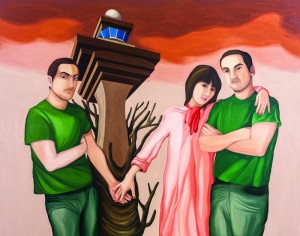Wir Drei at the Guggenheim Gallery
January 23, 2013

The
Guggenheim Gallery
at Chapman University is pleased to present
Wir Drei
, January 30, – March 2, 2013 (opening reception on Friday February 1st, 2013, 6-9pm with musical entertainment by No Vex - Lisa Madonna & Michael Doppa)a selection of contemporary figurative painting from Istanbul, Los Angeles and Düsseldorf. Nested symbolic systems, personal mythologies and psychological approaches are at the core of this exhibition. Coming from different backgrounds and generations, the eight artists in the exhibition employ a wide variety of figurative painting concepts.
The title, Wir Drei (We Three), is taken from a Yesim Akdeniz painting, which, in turn, is an homage to Phillip Otto Runge’s original work of the same title. Runge’s Wir Drei was painted in 1804 and destroyed by a fire in 1931 while in an exhibition at the Glaspalast in Munich. Typical for a romantic painting, it is full of symbolism and metaphor, filled with codes, hard to decipher today and leaves us wondering about what hidden desires and relationships are underneath the surface as the following quotes illustrate:
„The painting (depicting the artist with his wife and his brother) could be seen to exemplify the symbiotic romantic love relationship that is at the same time open to others. (…) it suggests a fusion of erotic love, which remains open to intimate friendship with others, (…)“—Encyclopedia of the Romantic Aera
“Philipp Otto Runge’s
We Three
is a “friendship picture”, a common genre in the Romantic age. (…) In the relationship between its three figures, you have the same sense of hidden depths that is characteristically found in the mono self-portrait (…) these depths are transmitted by faces (…) that both reveal and conceal the heart’s plots. We Three: you’ll never know.”—
Tom Lubbock, The Independent
Akdeniz’s version of the picture alludes to this symbolism and enigma. The roles are reversed, though. Keeping the original composition for the most part, Akdeniz assumes the pose of the woman, (the wife in the original), who now has a man on each side. Is it a joke? Or rather the opposite: a postulate of female power? Maybe both. The two men look like twins. Are they brothers, or two aspects of the same personality? Or do they represent the dichotomist, possibly schizophrenic relationship of the author to one person? We won’t get a definite answer. What we get is a pictorial space that clears for possible answers, a space that clears for interpretation.
The exhibition embraces this space, which opens up somewhere between image and psychogram, between genre and confession. It is a possibility of painting, that slides in and out of popularity, but always remains at the heart of the craft: The complex relations between the painter, the painted and the viewer. We Three.
For more information, please visit the Guggenheim Gallery website.

